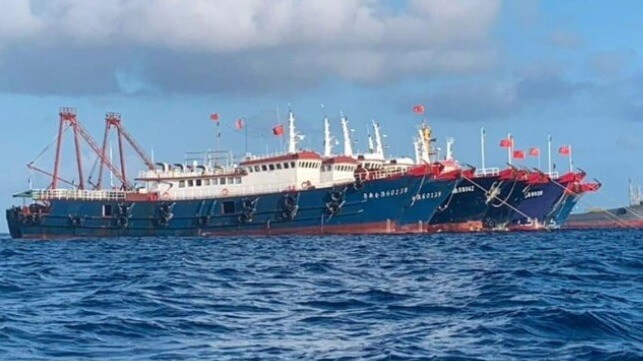The Quad's Space Initiative Shines Light on China's "Black Ships"

[By Philip Citowicki]
At the first in-person leaders’ summit of the Quad in Washington in September last year, the four member countries came forward with an ambitious space agenda. A working group was giving the task of advancing a number of key strategic areas, including the exchange of satellite data with the ambition to “protect the earth and its waters."
Little progress on space matters was obvious in the public domain in the months following, until in the lead-up to the second in-person leaders’ summit in Tokyo this week the Financial Times reported that a new maritime initiative would emerge from the gathering. The initiative would look to curb illegal fishing in the Indo-Pacific by using satellite technology to connect existing systems in the region to create a comprehensive tracking system. A US official stated that “China was responsible for 95 per cent of illegal fishing in the region."
The Quad Leaders’ Tokyo Summit Fact Sheet details this new Indo-Pacific Partnership for Maritime Domain Awareness (IPMDA), “a near-real-time, integrated, and cost-effective maritime domain awareness picture." It will look to harness commercially available data using existing technologies such as radio-frequency technologies. The Fact Sheet notes that due to its commercial origin, data will be unclassified, allowing the Quad to provide it to a wide range of partners who wish to benefit.
One aim will be to identify so-called “black ships”, those vessels that turn-off usual tracking transponders to engage in illicit activity such as illegal fishing, smuggling or piracy. Fishing fleets from China in particular have increasingly troubled countries in the Indo-Pacific and similarly plundered waters around the world. In March 2021, Chinese fishing vessels were found anchored in the Philippines’ exclusive economic zone and in one instance had rammed and sunk a Filipino fishing vessel. Sparking outrage from Ecuador, Chinese fleets have and been tracked to as far as the Galapagos and also stand accused of using “football stadium-style lighting” to plunder fisheries in shared waters between North Korea, Japan, and Russia.
The proliferation of earth observation and reconnaissance satellites make it now viable to track vessels that have turned off their transponders. As of 2022, there is an estimated to be about 5,700 operating satellites in space, with more are coming. In just the last year, more than 1,700 spacecraft and satellites went into orbit via 133 successful launches.
The IPMDA initiative would provide both environmental and security benefits to the region. Identifying China’s fleets would assist in levying faster attribution to their actions – it would support the region in pushing back against the grey-zone incursions into foreign waters and the bullying of local fishing vessels. Chinese ship have even been found not to be engaging in fishing, but instead encouraged financially to operate alongside Chinese law enforcement and military vessels to achieve political objectives in disputed waters.
The IPMDA should be strongly welcomed. It provides a substantive and a tangible action beyond the plethora of verbal commitments that emerge from other forums. It also builds on a bilateral agreements made by Quad member countries – it could also provide an avenue for integration with other countries interested in engaging with the Quad.
Philip Citowicki is a Non-Resident Fellow at the Pacific Forum and the Executive Officer of the Space Industry Association of Australia (SIAA). Philip was an adviser to former Australian Foreign Minister Julie Bishop and a former political aide to Australia’s High Commissioner to the United Kingdom.
This article appears courtesy of The Lowy Interpreter and is reprinted here in an abbreviated form. The original may be found here.
The opinions expressed herein are the author's and not necessarily those of The Maritime Executive.
